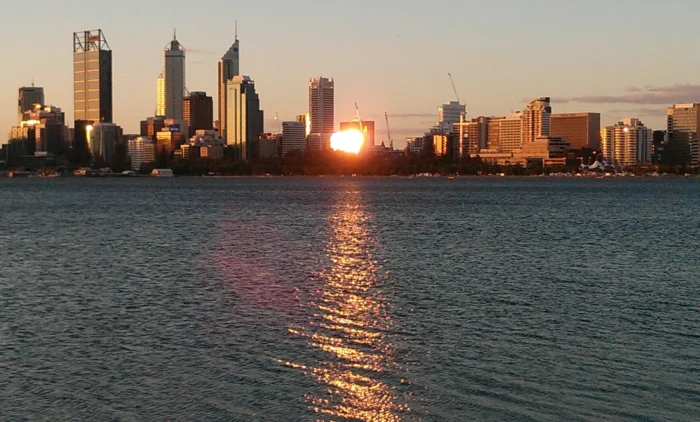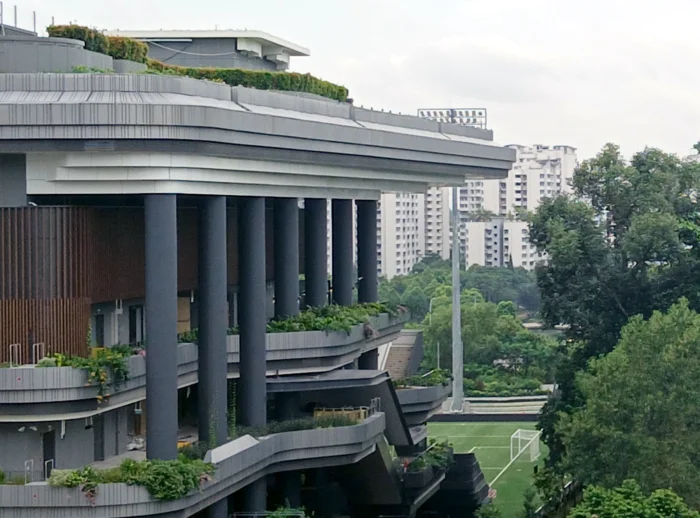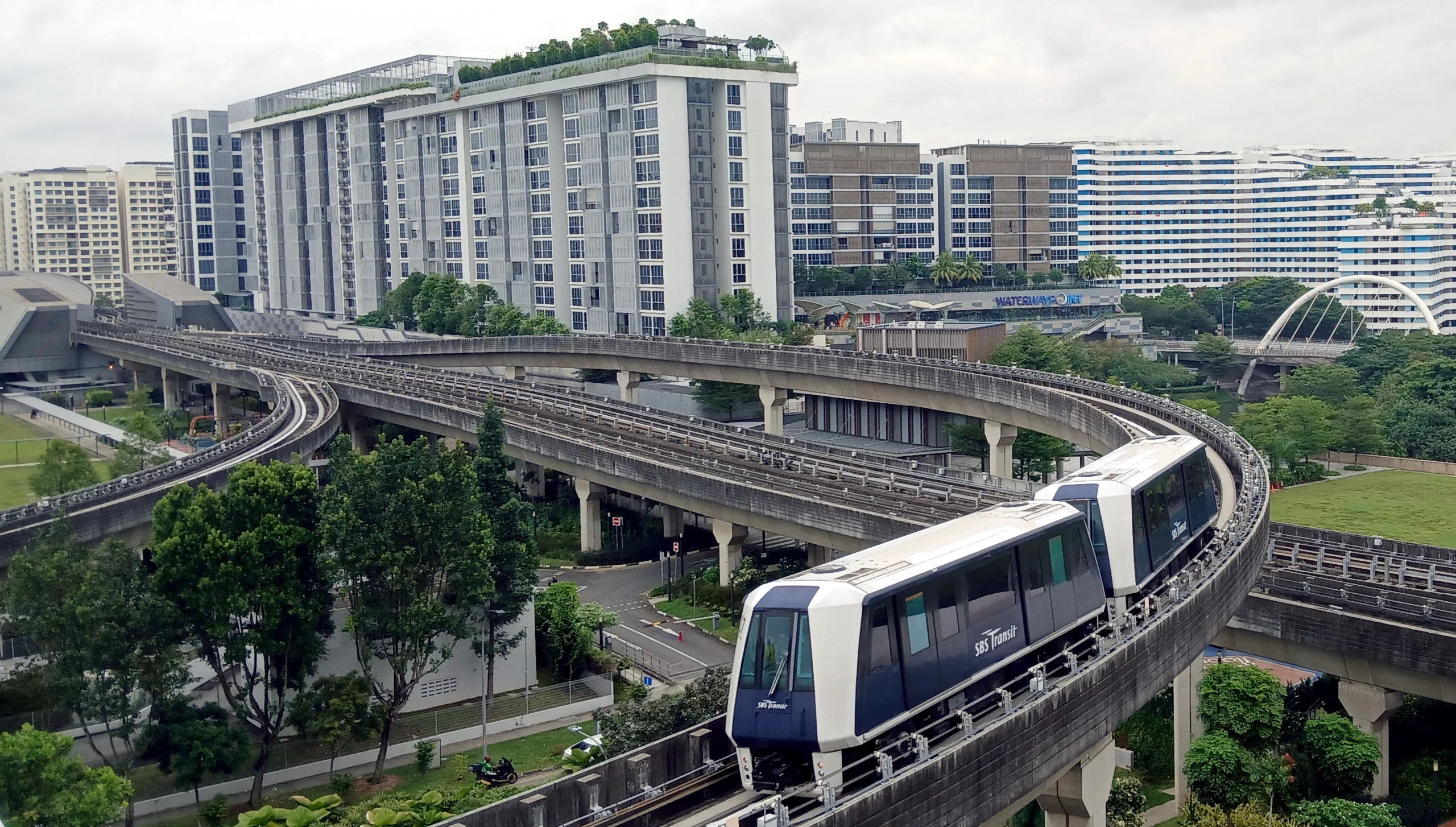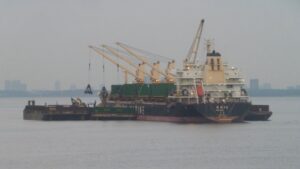Last Friday, my wife and I went night cycling. It’s one of the pleasures of living in Punggol, and it’s something we like to do whenever we can (preferably with the kids). Although we don’t always get the option, mostly due to inclement weather.
We had some books to return to the library, so we used that as an excuse to take a nice relaxing ride down to One Punggol, which is a ‘lifestyle hub’ – according to one web page. Apart from the five-story library, One Punggol boasts a seven-hundred seat hawker centre, lots of activity rooms and halls, a roof-top garden – including a BBQ area – plus much, much more. It really is a wonderful facility.
But, as they saying goes, there’s more. Just next door, they’re building a sports centre, that includes a football stadium, pools, gyms, and lots more.
In Perth, my original home town, those sorts of facilities would be restricted to the city centre, or possibly the western (well-to-do) suburbs. Yet, Punggol is at the furthest reaches of the island (which the locals call ulu).
Why can Singapore build such an elaborate amenity in its outer suburbs, but Perth (and the other Australian capitals) can’t?
Table of Contents
Differing Experiences
Apart from their very early years (when we lived in Australia), my kids have spent nearly their entire lives in Singapore. In comparison, I grew up in the Perth foothills, I spent most of my adult life living in South Perth. So there’s a large disconnect between our experiences.
Recently, I was explaining to them that a great number of their everyday conveniences are not the norm in Australia. They didn’t seem to understand.
“Isn’t Australia rich?” one of them asked.
“Yes,” I explained, “But it’s also massive.”
The inner suburbs of Perth are larger than all of Singapore. That means even basic amenities are spread out. That’s a concept my kids were not used to.
For instance, we live within easy walking distance (several hundred metres) of a couple of shopping malls (including supermarkets), many doctors and dentist clinics, various primary and secondary schools, as well as countless other amenities. That’s fairly typical of the newer estates in Singapore.
Compare that to when I was growing up in the foothills. I was fortunate enough to live about a hundred metres from the local primary school, but the secondary school was more than a kilometre away (with no public transport connection). The high school serviced not just my suburb, but all the surrounding suburbs (kilometres away). It remains the same, even to this day.
What Might Have Been
It’s not much different from what life would have been like had we remained in South Perth. There are several primary schools near where we lived, but the nearest state secondary schools are several kilometres1 away.
As far as shopping goes, in South Perth there aren’t any big shopping malls, like Punggol Waterway. The closest option would be to travel into the city centre (just across the river, but several kilometres away by road), to have a similar shopping experience.

It’s comparable when you look at medical facilities. The closest GPs and dentists were at least a kilometre away from where we lived. Worse, most weren’t open/or had limited hours over the weekend.
I remember having to travel down to Applecross to find a GP that was open on a Saturday afternoon when my eldest cracked his head open. Sure, Royal Perth Hospital is in the city, but the prevailing wisdom at the time was to avoid them if possible (I believe that has changed).
Compare that to where we live now, and every nearby doctor’s and dentist’s clinic is open every day of the year. There’s also Sengkang General Hospital not far away that has an emergency department.
Life in comparison is starkly different from how it could have been. Especially, when you consider that South Perth is considered a well-to-do suburb. There are worse places to live in Perth (like the foothills), and you need to travel much farther to receive even basic levels of service.
The Numbers
So, just how can Singapore deliver such a great life experience in comparison? The answer is fairly simple: density.
The suburb of South Perth (as opposed to the City o South Perth) and the residential areas of Punggol are about the same size: around 3 sq km. Yet, whereas South Perth has a population of roughly 12,500, Punggol’s population is nearly 200,000. And while South Perth’s population is mostly stable, Punggol’s is constantly growing. It’s nearly quadrupled since we moved here in 2009.
Most people living Punggol don’t reside in houses, which is typical for South Perth. Most live in HDB flats, eighteen (or so) story blocks containing about 100-120 individual apartments. That’s about 400+ people per block. The blocks are also built in clusters so it’s easy to have several thousand people living within a very small horizontal space.
Not only does that provide the population base for a great number of amenities, it demands it. Services would be swamped if they were built catering to a number of suburbs instead of just one. In fact, each cluster of blocks gets its own collection of services. This creates an almost village-like feeling. It’s quite wonderful.

The best thing is that if you do need to travel, there’s a world-class public transport system. Like in Perth, there’s an extensive bus services. Unlike in Perth, the buses arrive promptly and regularly every day from 5am until 11pm.
Compare that to when I lived in the foothills (admittedly many decades ago). On Sundays, there was a grand total of FOUR buses. Two heading to Perth, and two back. The last bus left Perth at 5pm, so if you missed it, you either needed to take a taxi or were in for a long walk.
In Punggol, apart from the buses, there’s also two LRT (elevated light-rail) lines, that service the local area, as well as a subway system, with another being built, that takes passengers across the island. It’s easy to get anywhere on the island, without needing to have a car or use a taxi. Of course, there’s also a cycling network, which still needs work, but it’s getting better.
I loved living in South Perth, particularly the climate, fresh air, and people. However, I no longer miss it.
The Punggol Life
In Punggol, we have a great life. It’s the small things that matter, especially being able to cycle safely at night, without the risk of being attacked (physically or verbally). Or having your tyre punctured, because some drunken fool thought that it was hilarious to smash their empty bottle of beer upon the cycle path. While such things didn’t happen all the time in Perth, they happened enough that I grew wary of going out (especially at night). It didn’t use to be that way. Perth used to be safe too.
So, my kids still don’t entirely understand how good they have it here, but I suspect that soon at least one of them (probably both) will head back to Oz to live for a while. So they can find out for themselves. I hope their experience there is a great as mine was.
- There are various religious schools that are closer. ↩︎














3 comments.
@skribe Punggol has grown into an amazing area & developed greatly over the past 5-6 years. Coney Island & Punggol Waterway Park are popular destinations that you’ve probably heard a lot about. And Lorong Halus Wetland, a picturesque area where you can get a perfect view of the sunset. The Singapore government is good at balancing the island state so that it’s not only the inner core that’s being developed. By the way, it looks the same in Sydney, as you describe Perth.
@smlx4 @skribe@skribeworks.com Waterway Park has changed a lot. My kids used to play there, but there's just some covered seats there now. Looking forward to the sports centre opening. It'd be nice not to have to travel to Sengkang for a swim.
[…] Will they survive, or will the curse claim another victim? I’m not overly hopeful, especially with one day until the end of July, and no sign of the stall opening. If they do miss the designated start date, it’s hardly an auspicious start. But that’s all part of The Punggol Life. […]